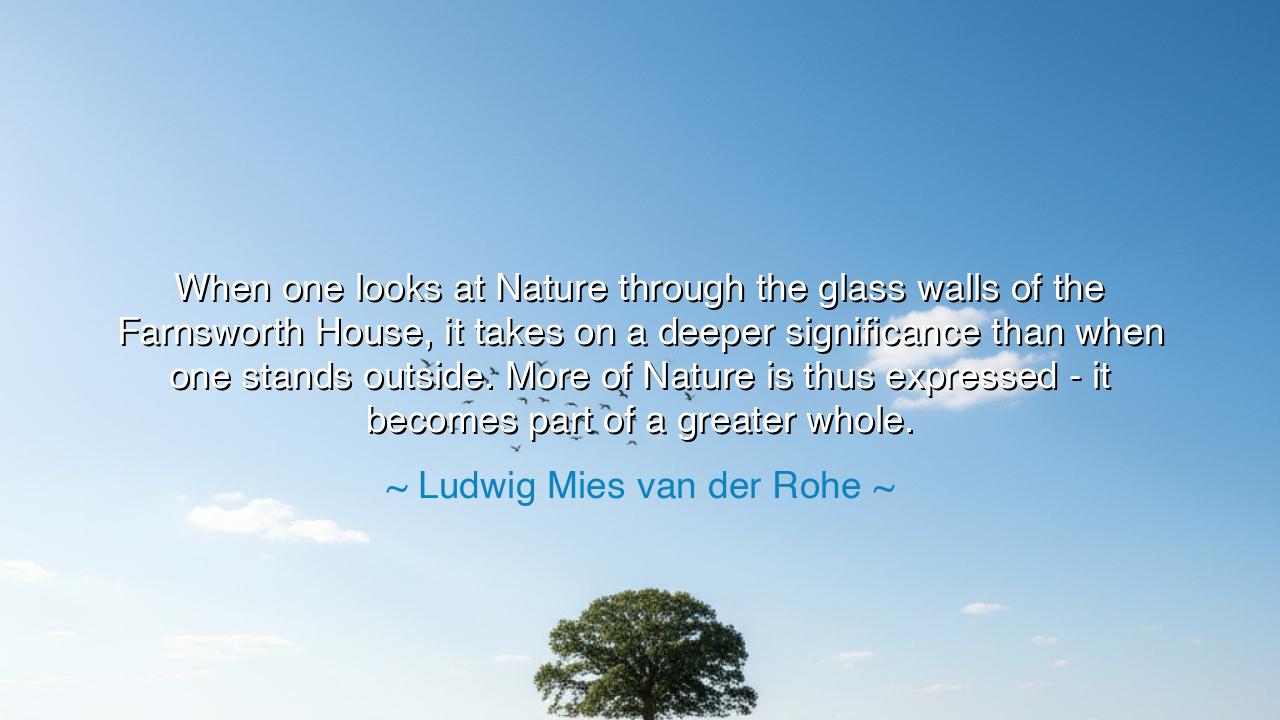
When one looks at Nature through the glass walls of the
When one looks at Nature through the glass walls of the Farnsworth House, it takes on a deeper significance than when one stands outside. More of Nature is thus expressed - it becomes part of a greater whole.






Hear now the words of Ludwig Mies van der Rohe, master builder of modern temples of glass and steel: “When one looks at Nature through the glass walls of the Farnsworth House, it takes on a deeper significance than when one stands outside. More of Nature is thus expressed — it becomes part of a greater whole.” In this saying, the architect reveals not only a truth of design but a truth of life: that sometimes we see more clearly not by stepping further into the world, but by framing it, by giving it context, by beholding it through a vessel shaped by human thought and craft.
The Farnsworth House, raised in the quiet of Illinois, is not a fortress against the wild but a dwelling that dissolves the boundary between man and the earth. Its walls are glass, its form suspended lightly above the ground, so that the trees, the river, the sky do not remain “outside” but flow into the very being of the house itself. Here Mies teaches us that Nature is not diminished by human design, but may be revealed more fully through it. By framing the forest within the clarity of glass, the house does not exclude but magnifies; it does not imprison but illuminates.
So too with the human soul. We are surrounded always by truth, by beauty, by greatness — yet how often do we fail to see? Our senses are overwhelmed by the infinite expanse. But when we frame experience, when we give it form, we awaken to its significance. Just as the window transforms the forest into a living picture, so too can discipline, ritual, or art transform chaos into meaning. Thus Mies’s vision transcends architecture: he speaks to the eternal human longing to see the world not as fragments but as a greater whole.
Consider the story of the Japanese tea house, a space simple and small, yet revered. In its confines, the visitor does not merely drink tea but encounters Nature through ritual — the curve of a bowl, the steam rising like morning mist, the window framing a single tree. Outside, the same tree may go unnoticed; inside, through the frame, it becomes profound. This is the same wisdom that Mies draws upon: that human craft, when humble and harmonious, does not compete with Nature but becomes its servant, heightening awareness and deepening reverence.
The meaning is clear: the union of man and Nature is not achieved by withdrawing wholly into the wild nor by conquering it with walls of stone, but by creating forms that harmonize with it, that allow us to see anew. The Farnsworth House, with its glass walls, becomes a parable of life itself: when we live with openness, when we remove the barriers of pride and fear, we discover that we are not separate from the world but participants in its vast design.
The lesson for us is this: frame your life in such a way that it reveals the beauty already present around you. Do not rush blindly through the forest, but pause, give it shape, see it through the lens of gratitude, through the stillness of reflection, through the craft of art. Whether through the window of a house, the page of a poem, or the silence of meditation, learn to behold the world as part of a greater whole. For when the heart is open as glass, even the ordinary reveals its significance.
Therefore, let these practical actions be taken: Create spaces in your life where the world may enter without obstruction. Design your home, your work, your days, not as barriers to Nature but as frames for it. Spend time gazing — through a window, through stillness — at the life that surrounds you. Practice the art of framing: in words, in gestures, in choices, shape your life so that the beauty of existence shines more clearly. And above all, live as one who knows that you are not apart from the whole, but woven into it.
So remember the words of Mies: through the glass walls of vision and openness, Nature is more deeply expressed. In such seeing, you too become part of the greater whole. This is the architecture not only of houses, but of the soul.






AAdministratorAdministrator
Welcome, honored guests. Please leave a comment, we will respond soon